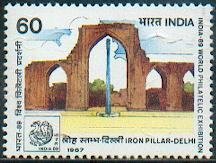Iron Pillar in Delhi: An Engineering Marvel that Withstood the Test of Time
The Iron Pillar in Delhi is one of the most remarkable engineering feats in Indian history. Located in the Qutub complex in Delhi, this 7.3-meter-high iron pillar has been standing for over a thousand years, defying the ravages of time, corrosion, and rust. Despite being exposed to harsh weather conditions, including monsoon rains, extreme heat, and humidity, the pillar remains intact and pristine, a testament to the ingenuity and skill of ancient Indian metallurgists.
The Iron Pillar was erected during the reign of Chandragupta II (375-415 AD), a prominent ruler of the Gupta dynasty. The pillar was initially installed in the ancient city of Udayagiri, near present-day Vidisha in Madhya Pradesh. It was later relocated to the Qutub complex in the 11th century by King Anangpal II of the Tomar dynasty.
One of the most remarkable features of the Iron Pillar is its composition. The pillar is made of wrought iron, which is an alloy of iron and a small amount of carbon. This composition makes the pillar more resistant to corrosion and rusting, compared to pure iron. It also makes the pillar tougher and more malleable, allowing it to be shaped into intricate designs and patterns.
Another fascinating aspect of the Iron Pillar is its inscription, which dates back to the 4th century. The inscription is written in Sanskrit and describes the conquests and achievements of Chandragupta II. It also includes a reference to the pillar itself, which was dedicated to the Hindu god Vishnu.
Despite its impressive composition and inscription, the Iron Pillar owes much of its durability to a unique protective layer that covers its surface. This layer, known as the patina, is a mixture of iron oxide, phosphate, and other compounds that form a dense, adherent coating on the surface of the pillar. This coating protects the underlying iron from further corrosion and damage.
Scientists and engineers have long been fascinated by the Iron Pillar's remarkable durability and have conducted several studies to understand its secrets. Some have suggested that the pillar's composition and protective layer are the key factors that have enabled it to survive for so long. Others have pointed to the pillar's unique location, which is sheltered from strong winds and direct sunlight, as a contributing factor.
In conclusion, the Iron Pillar in Delhi is a remarkable engineering marvel that has stood the test of time for over a thousand years. Its composition, inscription, and unique protective layer make it a source of fascination and inspiration for scientists, engineers, and historians alike. Whether you are a student of metallurgy, history, or architecture, a visit to the Iron Pillar is a must-do experience that will leave you awestruck by the ingenuity and skill of ancient Indian craftsmen.
